

Credits
for the info below goes to the Holly Fenelon Collection
Permission
Granted To Doc Dentice to Share On His Site
Below
you will read the stories and see the pictures of our Gold Star Mothers.
I
put this page up, in addition to my main Gold Star Mother site, because
of the amazing pictures and words Holly has to share.
Mr.
Harold Walters, had contacted me for help in getting information about
his Great
Grandmother,
who is a 2 star Gold Star Mother. So I contacted the Gold Star Mothers
National.
Then
I received an email from Holly Fenelon, offering to help Harold, and thats
how this story started.
Holly
is an unofficial historian for the American Gold Star Mothers, Inc. (AGSM).
She
recently published a book on the history of "Gold Star Mothers in America"
and the history of AGSM.
Another
book is in the works about the Gold Star Mother Pilgrimages.
Email
Holly Fenelon
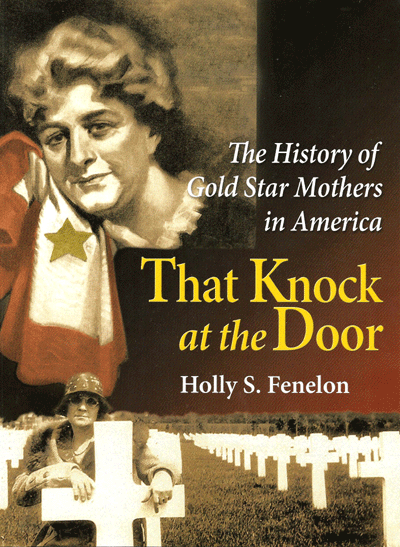
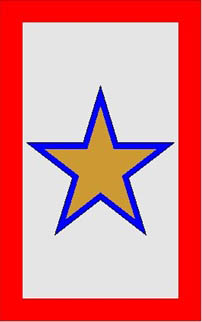
GOLD STAR HISTORY - GOLD
STAR PILGRIMAGE
Following
WWI, American families had a choice of burying their soldier sons among
their fallen comrades in Europe
or
having the body repatriated to the U.S. for burial. In either case, the
government paid for the burial. Approximately 1/3 of America's
WWI
casualties were buried in Europe in American military cemeteries established
in the early 1920s. (One was in Belgium,
another
in England – the others were in France.) That represented approximately
33,000 European burials.
Burial
in France was the decision that the Walters family made for Robert and
Valentine.
The
American Military Cemeteries were, for the most part, built on or near
the major battlefields of the war, and those
who
died were buried in the cemetery closest to where they fell. That is the
reason Robert and Valentine are buried
in
different cemeteries – Robert in the Meuse-Argonne Cemetery and Valentine
in the Oise-Aisne Cemetery.
In
the decade following the war, there were repeated calls from various groups
to somehow allow the families
(or
at least the gold star mothers) of the fallen to visit the European gravesites.
It wasn't until 1929 that an Act of
Congress
was passed to sponsor the Gold Star Pilgrimages of Mothers and Widows.
(Widows were eligible to
participate
if they had not remarried in the interim since the war.)
Under
the guidance of the Army Quartermaster Corps, between 1930 and 1933, approximately
6,400
women (the vast majority of the travelers were mothers) traveled to Europe
on month-long
trips
to spend time at the place where their child had been buried. (The travel
took place between
April
and September each year to take advantage of the best sailing weather.)
Despite starting
in
the earliest and worst years of the Depression, the trip included voyages
there and back on first
class
ocean liners on which the women were treated like royalty, time in Paris
to rest up from the
voyage
and to see the war memorials and other historical sites, and a few days
at the military cemetery
where
their child had found a final resting place. All of this was provided by
the government at no
cost
to the travelers (it was estimated to have cost $840 round trip per mother/widow).
It is almost
impossible
to describe the importance and power that this opportunity held for these
women; their
personal
stories of their travels are both wonderful and very sad to read.
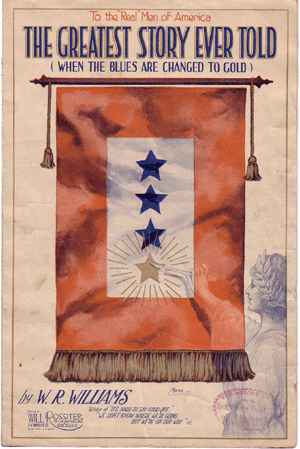
As
a "two star Gold Star Mother", Mrs. Walters would have had the opportunity
to spend time at
both
the Oise-Aisne Cemetery at Valentine's grave site and the Meuse-Argonne
Cemetery with Robert.
Guests
were allowed to accompany the mothers/widows, but were required to pay
their
own
way and, for some events, to make their own arrangements. I am aware of
very few mothers
and
widows who traveled with other family members – I think the cost was just
too prohibitive
for
most families at the time to allow additional family members to participate.
It would have
cost
quite a bit more than the $840 price tag calculated by the government.
In some cases, when
both
a mother and her son's eligible widow were going, they would choose to
travel together.
In
the Pilgrimage eligibility book (printed in 1929 by the government), Mrs.
Walters is noted as
hoping
to travel in 1930, the first year of the pilgrimages. The majority of the
travelers made
the
trip during that year – there were approximately 300 women leaving from
NY each week during
the
spring and summer to begin their trips to Europe. The trips were organized
by state so
often
travelers knew each other from their home towns.
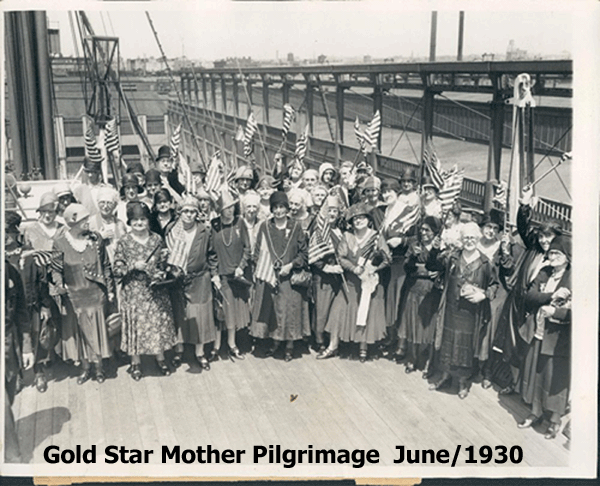
FROM THE HOLLY FENELON COLLECTION
Harold
– Your family history surrounding World War I is such a sad one. Two brothers
lost
in
the war and a third lost from despair. Most families didn't have to face
that much sorrow from the war.
I
checked the WWI membership records of American Gold Star Mothers, Inc.
and did not
find
Frances listed as a member of that gold star group. New York was the site
of another
gold
star group in the 1930s that was prominent in the news of the time, although
their
membership
never grew to more than a thousand members. (AGSM had approximately 25,000
members
at its peak following World War II and continues as an active organization
today.) The
New
York group was called American Gold Star Mothers of the World War, Inc.
(AGSM-WW).
There
is a possibility that Frances was a member of that organization since it
was pretty much
in
her backyard. New York also had a number of smaller gold star groups that
came together
during
and following WWI. Some mothers also joined the American Legion Gold Star
Auxiliary, the
gold
star auxiliary of the American War Mothers organization and a similar group
attached to
the
Veterans of Foreign Wars. I know she was not national president of
AGSM, but she might
have
served in that capacity for one of the other organizations. Nor would she
have been national
president
of AGSM-WW since the founder, Mrs. Mathilda Burling, served in that capacity
for
the 18+ years that the organization lasted.
AGSM
was founded in 1928; AGSM-WW was founded in 1930. If Mrs. Walters had an
opportunity
to
meet Mrs. Wilson it was probably during the war since neither President
Wilson nor his
wife
were much in the public eye following his term in office, due to the serious
stroke he had
suffered
while in office. Based on that, the meeting would not have been with either
of the AGSM groups.
Perhaps
she was part of a NY delegation to the White House or was invited for some
special event.
As
a two-star gold star mother, she would have been accorded special respect
by the government and the public.
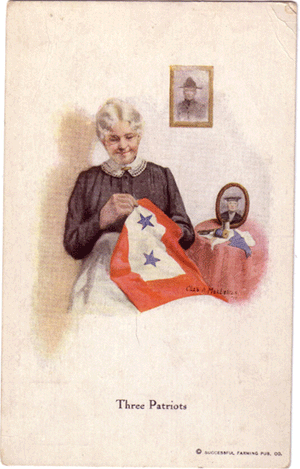
One
thing that many folks do not understand is that the term "gold star mother"
is a public
term,
rather than a government term. It comes directly from the service flag
(or service banner)
that
families hung in their windows with blue stars for family members who were
serving in the
military.
Gold stars were applied over the blue star representing a family member
if that individual
gave
his life in the line of duty. The family flag that you described with two
gold stars and one blue
star
would have shown three blue stars for most of the war, but two of the stars
would have been
changed
to gold to reflect the death of Robert and Valentine. Mrs. Walters was
a gold star
mother
by virtue of her loss, regardless of whether she joined one gold star mothers
organization,
several of them or none at all.
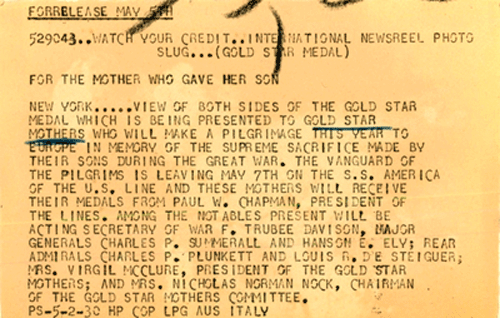
As
an aside, service flags were patented in 1917, shortly after the U.S. entered
WWI in April.
They
were the idea of a retired Army veteran who invented them as a way to honor
his family
members
who were serving in the military. To use today's term, the service flag
idea quickly
went
"viral" and they soon appeared in every corner of the U.S. They were
commercially manufactured
and
available in stores, but many families chose to make their own. They were
made of felt, cotton,
satin
and just about any other material that was available. Some were made of
paper while others
were
crocheted or knitted. You could buy a crochet pattern for a service flag
and stars for 12 cents
and
a self-addressed stamped envelope! In 1918, Liberty magazine printed the
image of a service flag
on
its cover with additional stars inside the magazine that could be cut out
and glued to the paper flag.
Some of the items Harold described from her trip are familiar to me:
·
A bronze medallion showing a ship, the Statue of Liberty and the Eiffel
Tower on the front
was
given to each traveler by the U.S. Shipping Lines as a souvenir of their
voyage across the
Atlantic.
It was designed by Tiffany. It came boxed with a long red, white and blue
ribbon, designed
to
be worn around the neck. The year printed on the medallion would have been
1930 or 1933 although
voyages
were made in 1931 and 1932 as well. They just used the 1930 medallions
until they ran out
and
then had another group printed with 1933 on them. There is a number stamped
on the edge of
the
medallion – it indicates the tracking number associated with the medallion.
Each medallion came
with
a certificate made out with the recipient's name and the medallion number.
(You can see the
front
and back on the attached Medallion Press photo; the certificate is shown
on the GS Pilgrimage
Medallion
Certificate – Sarah Russ 1930 photo.)
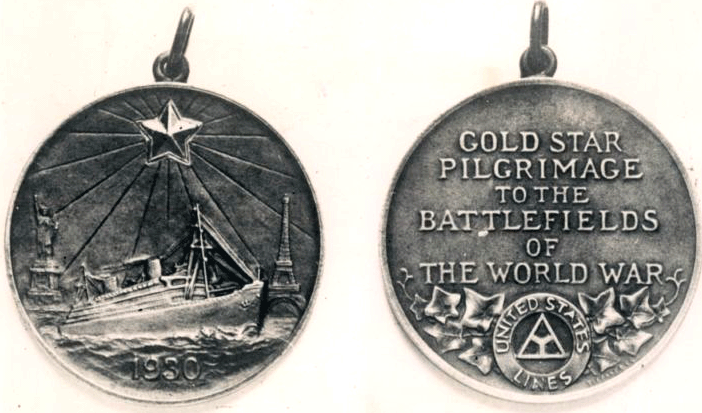
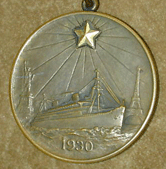
·
Each mother and widow received a photograph of her standing by the headstone
of their
son
or husband's grave. (See attached Mother Hommon at grave photo for an example.)
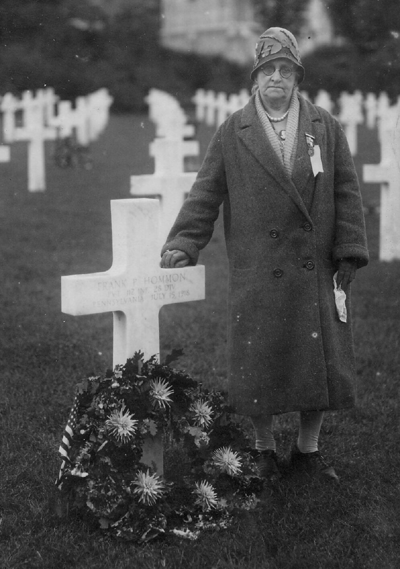
MOTHER HOMMON
Other
items that each traveler received included:
·
A name badge prepared by the government that they were asked to wear at
all times. (example attached)
·
An American flag that could be rolled and stored in a tube; the tube became
a handle for
the
flag when in use. This was provided by the City of New York to each mother
and
widow who participated in the Pilgrimages.
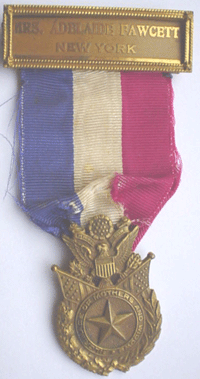
·
Two special passports issued specifically for the Pilgrimage travelers
– one was black and one was red.
·
The travelers received copious amounts of information from the Quartermaster
Corps
prior
to beginning their trips. There were itineraries for traveling from their
homes to NYC, instructions
for
every aspect of the trip, train schedules, information on what could be
brought in terms of luggage, etc..
At
each phase of the journey, additional materials were handed out concerning
schedules, menus,
sightseeing
opportunities, the location of their child's grave at the cemeteries, etc.
To
the best of my knowledge, there is currently no place in which the history
of various gold star mothers
is
retained. You might be successful looking in the old archives of the NY
Times for information
about
her and her losses. It may help to know that she would have been well-known
in her community and
state
as the gold star mother of two soldiers and many special opportunities
were probably made available
to
her beyond the Pilgrimage and a visit to the White House. The soldiers
who returned from WWI made
it
a special mandate to recognize and care for the mothers and families of
their comrades who had not returned.
The
link below takes you to Ancestry.com's data base on the women who were
eligible to participate
in
the Pilgrimages – there's not much information provided but it was the
official government list at the time:
Gold
Star Pilgrimages - Ancestry.Com